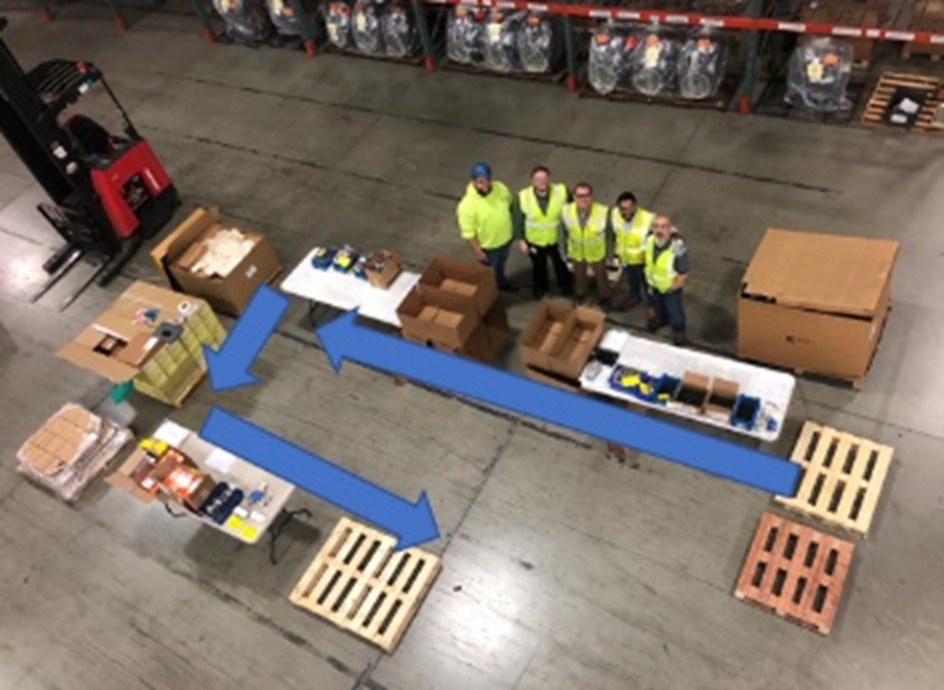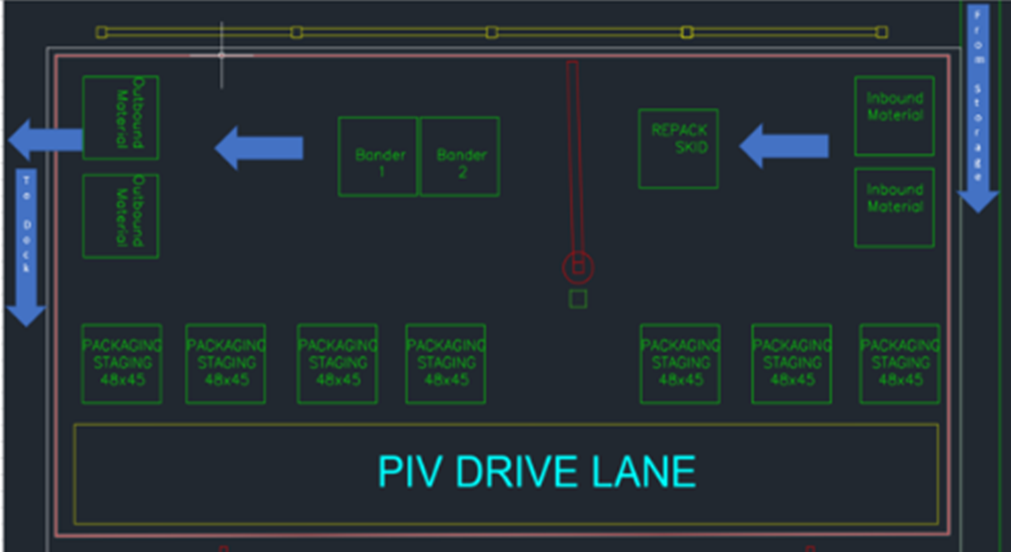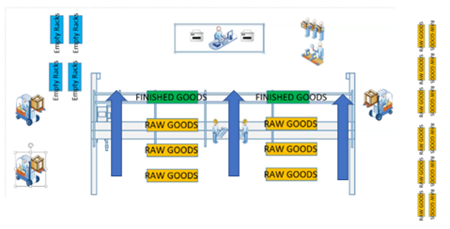Apr 14, 2022
4 Steps to Maximize Warehouse Design
Building Up or Building Out?

By Mitchell Houston, TA Services Continuous Improvement Engineer in collaboration with Aron Scalissi, TA Services Director of Warehouse Operations
Warehouse design is a critical step in setting the table for successful warehouse operations over the long term. Whether it be the layout of a singular work cell inside the warehouse or setting up storage strategies and traffic patterns to optimize the entire flow for your warehouse; a few simple tools can make a massive impact. There are several important factors to consider when structuring a process flow such as minimizing travel time between tasks and proper storage mechanisms for your material. TA Services has extensive experience in the 3PL market when it comes to setting up these design flows for maximum productivity.
Determining the best storage mechanism for your product mix, thinking about both the inbound and outbound aspects before starting, and shaping flows to suit your building layout are all great ways to keep operations lean, effectively reducing waste and other costs. Join us as we explore four steps for maximizing your warehouse design.
Step 1: Know what you are storing and be smart about storage mechanism options
When designing a warehouse, a key input is the style or type of storage mechanism that will be required for your product mix. Are you dealing with small parts that need to be segregated into bins? Full standard size pallets? Open floor storage? Or something completely different?
TA Services has engineered storage solutions for many unique product types including automotive, food grade, even steel mill services. These types of products require a custom solution, and their characteristics are important in determining the best way to store the material. Some important factors taken into consideration for optimal storage are:
- How tall are the pallets?
- How many need to be stored at any given time?
- How often they will be shipping out to the customer?
Consider optimal height requirements
Storage racks are a common way to house material in a warehouse, but determining how high those racks need to go, how many levels of storage, and how wide the openings need to be all depend on the product. We want to avoid any excess “air” in our warehouse. When we could store material instead, every available inch of space is gold. Even the width of the travel aisles and what type of powered equipment will be used is taken into consideration during this step.
Doing this homework before designing the warehouse leads to efficient and cost-effective storage options customized to each shipper’s needs. Determining the type and size of each kind of storage required in the layout design is important so they can be melded together to find the best use of available square footage.
Step 2: Engineering Wholistically – know where the product is going and the best way to get it there
Thinking about the warehouse design process with the end goal in mind is an outstanding concept to help reduce deviations and prevent issues down the road. It is worthwhile to consider how the material will be picked and shipped to the customer, and it is vitally important to consider the process from start to finish. A great shipping process is only as good as your ability to get the material to the shipping area! If the material gets bottlenecked in the receiving portion of your process, a super optimized shipping station will never see its full potential. The same concept applies for inbound items moving to the storage area.
Consider arrival characteristics of the product
We must consider how the material comes in the building before being stored, because if the first step in our process causes slowdowns or errors, that inefficiency will trickle down throughout the process, which is obviously a big no-no. A well-known lean concept is that a defect or slowdown should never travel downstream to the next department or area, as the error only compounds the time and cost for the company the closer it moves to the customer. Designing flows to be balanced and thinking with the entire process in mind, as opposed to a departmental silo, will lead to the ideal designs.
Step 3: Reduce Bottlenecks!
In addition to the blockage of materials at the receiving portion of the process, one of the biggest resource wastes in any warehouse is unnecessary travel caused by an inefficiently executed warehouse plan. Designing a warehouse flow to decrease the number of bottlenecks caused by pedestrian, forklift, and product movement is crucial to creating an effective operation. With proper warehouse configuration, you can store materials that are frequently picked together in the same area and reduce needless touchpoints, saving you time and potential damages.
Find your flow
These flows can be done linearly or in a “U” shape depending on the scale of the operation. Some of the tools that are commonly used to optimize these flows include slotting based on part velocity (and other factors) via heat mapping. Inbound product comes into one side of the building, the material is stored in the middle, and then shipped out of the other side. This prevents any material from backtracking to a location it has already visited at some point during the process.
Minimizing the amount of “touches” freight gets within the warehouse helps prevent opportunity for error or freight damage, as well as keeps the operations efficient. On a smaller scale, a single work cell within the warehouse can be designed with a U-shape flow, allowing the material to come into one side of the cell and then be processed, repacked, decanted, inspected, and flow out of the other side in a “U” shape or near circular flow. This allows ample space for processing, tool storage, and provides great separation from the incoming and outgoing material.

When creating a flow within your warehouse, material storage location is not random! TA Services utilizes a velocity-based heat mapping tool to find material that is frequently picked together and could be stored in the same place, creating an efficient travel path between parts. Based on the data provided from the heat mapping tool, the most commonly picked parts are stored in optimal picking locations throughout the warehouse.
This provides a business advantage through data-based slotting of parts and optimized travel paths, reducing operator travel time during the storage process as well as the shipping process. Slotting can also be done in a variety of other ways and can be based on product size, weight, or type. A combination of these approaches usually leads to the most optimal configuration for operator safety, efficiency, and cost effectiveness.

Step 4: Choose the right partner
A glimpse into the warehouse design process does not begin to scratch the surface of all the engineering factors that go into a successful layout. With a little help from some outstanding tools and a world class team – your 3PL partner can make the difference between a good experience and a great one. TA Services can make ship happen and improve warehouse operations in a way that is bold in thought and allows us to go the extra mile, every mile.
TA Services is a trusted name in the supply chain industry offering full service third-party logistics (3PL) solutions to shippers of all sizes. We offer multimodal freight brokerage, managed transportation, warehousing and fulfillment, and cross-border logistics expertise to solve your supply chain problems of any size. With 2MM+ SqFt of Dedicated and Multi-Client sites, we are where you need to be. If not, we can be.
Utilizing some of the basic lean concepts and following the 4 steps to maximize warehouse design will prepare you for your warehousing journey. Knowing the product characteristics, considering your storage mechanism options, looking at the process wholistically, and choosing the right 3PL provider for your warehousing and fulfillment needs will put you in a position to succeed. For more information on how TA Services can upgrade your logistics workflow or manage your storage and fulfillment needs, visit our website.
For related articles, check out:
Streamline Warehousing with the 5S Method
The TA Difference: Lessons from TA Leadership – David Bowers, VP Warehouse Operations
TA Services Warehousing Facility Honored with Wisconsin Corporate Safety Award



